- Clone
- 6B10.2 (See other available formats)
- Regulatory Status
- RUO
- Other Names
- CD247, CD3zeta
- Isotype
- Mouse IgG1, κ
- Ave. Rating
- Submit a Review
- Product Citations
- publications
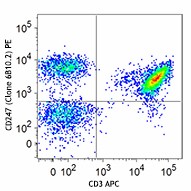
-

Human peripheral blood lymphocytes were surface stained with CD3 APC and then treated with Fixation Buffer and the Permeabilization buffer. Cells were then stained with CD247 (clone 6B10.2) PE (top) or mouse IgG1, κ PE isotype control (bottom). -

| Cat # | Size | Price | Quantity Check Availability | Save | ||
|---|---|---|---|---|---|---|
| 644105 | 25 µg | 153 CHF | ||||
| 644106 | 100 µg | 360 CHF | ||||
The invariant TCR zeta chain is a member of the CD3 complex associated with the clonotypic alpha/beta TCR heterodimer. The disulfide-linked TCR zeta homodimers transmit signals following TCR ligation. Loss of TCR zeta expression has been reported in a diverse range of disease states, including autoimmune diseases, many neoplastic conditions and chronic infections, such as tuberculosis and leprosy.
Product DetailsProduct Details
- Verified Reactivity
- Human
- Antibody Type
- Monoclonal
- Host Species
- Mouse
- Immunogen
- Human TCR-zeta peptide
- Formulation
- Phosphate-buffered solution, pH 7.2, containing 0.09% sodium azide.
- Preparation
- The antibody was purified by affinity chromatography and conjugated with PE under optimal conditions.
- Concentration
- 0.2 mg/ml
- Storage & Handling
- The antibody solution should be stored undiluted between 2°C and 8°C, and protected from prolonged exposure to light. Do not freeze.
- Application
-
ICFC - Quality tested
- Recommended Usage
-
Each lot of this antibody is quality control tested by intracellular immunofluorescent staining with flow cytometric analysis. For flow cytometric staining, the suggested use of this reagent is ≤0.2 µg per million cells in 100 µl volume. It is recommended that the reagent be titrated for optimal performance for each application.
- Excitation Laser
-
Blue Laser (488 nm)
Green Laser (532 nm)/Yellow-Green Laser (561 nm)
-
Application References
(PubMed link indicates BioLegend citation) - Product Citations
-
- RRID
-
AB_2565720 (BioLegend Cat. No. 644105)
AB_2565721 (BioLegend Cat. No. 644106)
- Disclaimer
-
This product is for in vitro research use only. It is not to be used for commercial purposes. Use of this product to produce products for sale or for diagnostic therapeutic or drug discovery purposes is prohibited. In order to obtain a license to use this product for commercial purposes contact The Regents of the University of California.
Antigen Details
- Structure
- Structure: 163 amino acid long protein (predicted MW is 18kDa), with a short extracellular domain of only nine amino acids conserved between mouse and human. There are 6-7 intracellular tyrosines that are potential phosphorylation sites.
- Distribution
-
T cells and NKT cells. Reported also positive on CD16+ human NK cells.
- Function
- Mediating signal transduction after TCR receptor engagement.
- Interaction
- ZAP70, TCR alpha/beta
- Cell Type
- NKT cells, T cells
- Biology Area
- Cell Biology, Immunology, Signal Transduction
- Molecular Family
- CD Molecules, TCRs
- Antigen References
-
1.Weissman A, et al. 1988. P. Natl. Acad. Sci. USA 85:9709
- Gene ID
- 919 View all products for this Gene ID
- UniProt
- View information about CD247 on UniProt.org
Related Pages & Pathways
Pages
Related FAQs
- What type of PE do you use in your conjugates?
- We use R-PE in our conjugates.
Other Formats
View All CD247 Reagents Request Custom Conjugation| Description | Clone | Applications |
|---|---|---|
| Purified anti-CD247 (TCRζ, CD3ζ) | 6B10.2 | WB,ICFC |
| FITC anti-CD247 (TCRζ, CD3ζ) | 6B10.2 | ICFC |
| PE anti-CD247 (TCRζ, CD3ζ) | 6B10.2 | ICFC |
| TotalSeq™-C1489 anti-CD247 (TCRζ, CD3ζ) Antibody | 6B10.2 | ICPG |
Customers Also Purchased
Compare Data Across All Formats
This data display is provided for general comparisons between formats.
Your actual data may vary due to variations in samples, target cells, instruments and their settings, staining conditions, and other factors.
If you need assistance with selecting the best format contact our expert technical support team.
-
Purified anti-CD247 (TCRζ, CD3ζ)
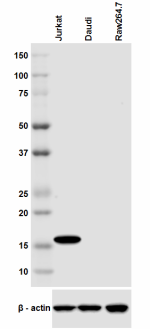
Total lysates (15 µg protein) from Jurkat, Daudi (low expres... -
FITC anti-CD247 (TCRζ, CD3ζ)

Human peripheral blood lymphocytes surface stained with CD3 ... -
PE anti-CD247 (TCRζ, CD3ζ)

Human peripheral blood lymphocytes were surface stained with... 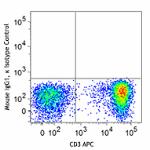
-
TotalSeq™-C1489 anti-CD247 (TCRζ, CD3ζ) Antibody
 Login / Register
Login / Register 










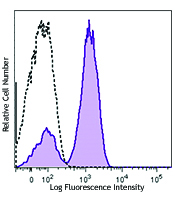


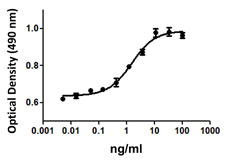



Follow Us